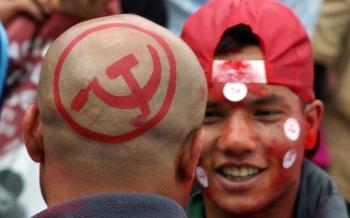– Daphna Whitmore
Some walked for miles to cast their vote. It was soon clear millions had voted for radical change in Nepal. The Maoists are by far the largest party in the Constituent Assembly and have promised to end the feudal-monarchy and to mobilise against poverty and repression.
The groundswell began in 1996 with a Maoist-led armed struggle in the rural areas. Within a decade they had established Red Zones in 80 percent of the countryside. Land reforms, campaigns for women’s equality, literacy drives and new infrastructure projects changed the physical and political landscape.
Jared Phillips from the Workers Party travelled to Nepal in 2003 and was one of the first Westerners to visit the Red Zones. He was impressed by what he saw and spoke of the women’s movement there. “It is one of the most advanced in the world today” he said. “The difference between the situation of women in the liberated areas and women in old Nepal was mind-blowing. In Kathmandu women were like slaves to the men; waiting on them hand and foot. Walking along the street women would have their eyes to the ground. What a contrast it was in the Red Zones. Women would come up and give the clench-fist salute and shake my hand saying ‘Lal Salaam’, which means red salute. They were very confident, and self-assured.”
The guerrilla units grew into a 30,000-strong People’s Liberation Army which was able to fight the King’s army to a standstill. India, the US and Britain sent military advisers, money and equipment to prop up the old regime but the revolution kept growing.
The King and his supporters fought back viciously. A United Nations study reported that in 2003 and 2004 Nepal had the highest rate of disappearances in the world. (www.amnesty.org) Of the 13,000 killed in the war 10,000 died between 2003 and 2006. Most of the killings were by the Royal Nepalese Army and its victims were civilian supporters of the Maoists. Human Rights Watch confirms that at least two-thirds of the killings were by the government forces. (http://hrw.org)
In 2005 King Gyanendra sacked the government and declared a state of emergency. The Maoists led mass protests against the autocracy and showed remarkable tactical skill in drawing together an alliance of all the parliamentary parties. They called for an elected Constituent Assembly which would draft a new constitution, and for an end to the monarchy. They won not only the majority of seats in the countryside but also four out of ten in Kathmandu.
The Constituent Assembly has a very different face to the old parliament. Only one Dalit (untouchable) had ever been elected before. This time eight were voted in; all of them Maoists. There are many more women and minorities elected this time too. Of the 29 women who won seats 23 of them are Maoists.
The big question now is how far can the new government advance the revolution?
There is no denying the conditions for socialist transformation do not yet exist in Nepal which is chronically under-developed and the working class a tiny minority. The first task is to get rid of feudalism. The King has been told he can stay in the country but his palaces and landholdings will be nationalised. The Maoists will continue their struggle against caste divisions and pursue land-reform which began during the people’s war under the principle “land to the tiller”.
The Nepalese Army and the People’s Liberation Army will be integrated and there is talk of the army being scaled down and people’s militias being formed.
The Maoists want rapid industrial development, but as Baburam Bhattarai points out, “We don’t have enough resources and skill to reorganise the country in the way we want to. It may take at least 10 to 15 years to do it”. Foreign investors are being welcomed – out of necessity – to fund huge infrastructure projects including roading, rail and hydro projects. While seeking outside capital the aim is to develop Nepal’s own productive capacity.
Education is a key part of the new government programme. Private schools up to high school level will be taken over by the state says Bhattarai. “It is the government’s responsibility to provide equal education to everybody,” he said. “Differences in the quality of education widen the divide between the rich and poor and create strife”.
The election marks a turning point in the country’s history and a step forward for liberation movements internationally. All eyes will be on the new Nepal.

